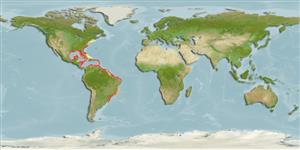>
Eupercaria/misc (Various families in series Eupercaria) >
Lutjanidae (Snappers) > Lutjaninae
Etymology: Rhomboplites: Greek, rhombos = paralelogram + Greek, hoplon, hoplites = with a shield (Ref. 45335).
More on author: Cuvier.
Environment: milieu / climate zone / depth range / distribution range
экология
морской демерсальный; пределы глубины 40 - 300 m (Ref. 9626), usually 40 - 100 m (Ref. 9626). Subtropical; 42°N - 33°S, 99°W - 30°W (Ref. 55)
Western Atlantic: Bermuda and North Carolina, USA, to São Paulo, Brazil (Ref. 57756), including West Indies, Gulf of Mexico and Caribbean Sea (Anderson, pers. comm.).
Length at first maturity / Size / Вес / Возраст
Maturity: Lm 18.8, range 15 - 23 cm
Max length : 60.0 cm TL самец/пол неопределен; (Ref. 26938); common length : 35.0 cm TL самец/пол неопределен; (Ref. 55); наибольший вес (опубликованные данные): 3.2 kg (Ref. 40637); наибольший возраст (опубликованны данные): 10 годы (Ref. 3090)
колючие лучи спинного плавника (общее число) : 12 - 13; членистые (мягкие) лучи спинного плавника (общее число) : 10 - 11; колючие лучи анального плавника: 3; членистые (мягкие) лучи анального плавника: 8. Snout short, lower jaw slightly projecting. Mouth small. Pectoral fins relatively short, not reaching level of anus. Scale rows on back rising obliquely above lateral line. Back and upper sides vermilion, shading to silvery with reddish tinge ventrally, with narrow horizontal yellow lines below the lateral line. The dorsal and caudal fins yellowish; the anal and pelvic fins whitish.
Adults are found in moderately deep waters, most common over rock, gravel or sand bottoms near the edge of the continental and island shelves, often in large schools. Young fish occur in shallower depths (below 25 m), also often forming large schools. They feed on fishes, shrimps, crabs, polychaetes, other benthic invertebrates, cephalopods and planktonic organisms. Good food fish (Ref. 9626).
Spawning occurs over most of the year with peak activity during spring and summer, at least in the northern part of the range (Puerto Rico to the Carolinas).
Allen, G.R., 1985. FAO Species Catalogue. Vol. 6. Snappers of the world. An annotated and illustrated catalogue of lutjanid species known to date. FAO Fish. Synop. 125(6):208 p. Rome: FAO. (Ref. 55)
Статус Красного Списка МСОП (Ref. 130435: Version 2024-2)
Угроза для людей
Harmless
Использование человеком
рыболовство: не имеет хозяйственного значения; объект спортивного рыболовства: да
дополнительная информация
инструменты
Специальные отчеты
Скачать в формате XML
ресурсы в Интернет
Estimates based on models
Preferred temperature (Ref.
123201): 18.3 - 27.2, mean 23.9 °C (based on 185 cells).
Phylogenetic diversity index (Ref.
82804): PD
50 = 1.0000 [Uniqueness, from 0.5 = low to 2.0 = high].
Bayesian length-weight: a=0.01514 (0.01334 - 0.01717), b=2.96 (2.93 - 2.99), in cm total length, based on LWR estimates for this species (Ref.
93245).
Trophic level (Ref.
69278): 4.4 ±0.2 se; based on diet studies.
Generation time: 12.2 ( na - na) years. Estimated as median ln(3)/K based on 2
growth studies.
устойчивость к внешним воздействиям (Ref.
120179): средний (среднего размера), минимальное время удвоения популяции 1.4-4.4 года (K=0.20; tm=3; tmax=10).
Prior r = 0.43, 95% CL = 0.28 - 0.64, Based on 3 full stock assessments.
Fishing Vulnerability (Ref.
59153): Moderate to high vulnerability (50 of 100).
Climate Vulnerability (Ref.
125649): High to very high vulnerability (74 of 100).
Nutrients (Ref.
124155): Calcium = 57.3 [19.9, 118.3] mg/100g; Iron = 0.974 [0.512, 1.815] mg/100g; Protein = 18.9 [17.1, 20.6] %; Omega3 = 0.408 [0.255, 0.664] g/100g; Selenium = 33.1 [17.3, 65.9] μg/100g; VitaminA = 21.1 [6.4, 83.8] μg/100g; Zinc = 0.526 [0.349, 0.788] mg/100g (wet weight);
